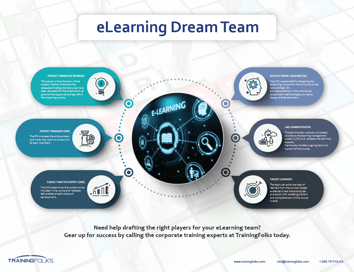Why eLearning is Good for Remote Workforces
 Over the last few years, remote and hybrid work has become part of normal everyday business. Consequently, eLearning has become a crucial training tool for remote workforces, providing accessibility, scalability, and flexibility.
Over the last few years, remote and hybrid work has become part of normal everyday business. Consequently, eLearning has become a crucial training tool for remote workforces, providing accessibility, scalability, and flexibility.
Explore why eLearning is good for remote workforces and how it can help organizations train and develop their employees in an efficient and effective manner. We will also discuss the various eLearning development tools and strategies that can be used to create engaging and impactful training programs for remote workforces.
One of the main advantages of eLearning is its accessibility, as it allows learners to access training material from anywhere and at any time, making it an ideal solution for employees working in different time zones. Furthermore, eLearning provides consistent training experience to all learners, ensuring that they all receive the same level of training regardless of their location while still providing personalized learning for individuals upskilling and reskilling needs.
Additionally, eLearning is highly scalable, allowing companies to provide training to an unlimited number of learners, regardless of their location. With eLearning, remote workforces can receive the same quality of training as their in-office counterparts, leading to improved learning outcomes and job performance.
While many companies have adopted eLearning in their learning strategies, there are many that are still considering how to transition from traditional learning to a more blended learning approach. Let's explore some of the key benefits of eLearning a little deeper.
Accessibility
eLearning has revolutionized the way people learn and acquire new skills. One of the most significant advantages of this learning method is that it provides learners with the freedom to access the training material from anywhere, at any time. This means that learners no longer have to worry about being physically present in a particular location to attend a training session. Instead, they can log in to the eLearning platform from their homes, offices, or even while on the go, using their mobile devices.
This accessibility is particularly beneficial for remote and distributed workforces that operate in different time zones. Traditionally, scheduling training sessions for these teams has been a logistical nightmare. It is often challenging to find a time that suits everyone's availability. With eLearning, however, learners can access the training material whenever it is convenient for them.
Moreover, eLearning enables companies to provide consistent training to their remote and distributed workforces. With traditional training methods, there is always the risk that some team members will miss out on critical training sessions due to scheduling conflicts. eLearning eliminates this risk by providing learners with access to the same training material, regardless of their location or time zone. This ensures that everyone receives the same level of training, leading to a more efficient and effective workforce.
Consistency
eLearning provides a standardized and consistent approach to training delivery, ensuring that all learners receive the same level of training. The training material is presented in a pre-defined format, which ensures that all critical topics are covered, and learners receive the same information, regardless of who is delivering the training. Moreover, eLearning Learning Management Systems (LMS) provide the ability to track learners' progress and ensure that they have completed all required modules and assessments.
Another advantage of eLearning's consistency is that it leads to better learning outcomes. When learners receive consistent training material, they can focus on understanding the content instead of trying to piece together information from different trainers. This results in improved knowledge retention and application, which is crucial for learners to perform their jobs effectively.
Furthermore, eLearning's consistency ensures that companies comply with industry standards and regulations. Many industries require employees to receive training on specific topics regularly. With eLearning, companies can ensure that all employees receive the required training, and compliance can be tracked efficiently.
Flexibility
eLearning also provides learners with flexibility in terms of pacing and learning style. Remote and distributed workforces often have varying levels of experience and expertise, which can make it challenging to provide training that suits everyone's needs.
With eLearning, learners can proceed at their own pace and choose the learning style that works best for them. This makes it easier to provide training that is tailored to the individual needs of each learner.
Scalability
eLearning has become a popular training method for many organizations worldwide, primarily due to its scalability. This training method's ability to cater to an unlimited number of learners has made it an ideal solution for remote and distributed workforces.
eLearning is highly scalable, and there is no limit to the number of learners that can access the training material simultaneously. With the right eLearning platform, companies can create and upload training material that can be accessed by learners from anywhere and at any time. This makes it easier for organizations to train large numbers of employees, regardless of their location.
Performance tracking
eLearning provides companies with the ability to track learners' progress and performance. Traditional training methods often do not provide any means of tracking learners' progress and performance. With eLearning, companies can track learners' progress and performance in real-time. This allows companies to identify any areas where learners may be struggling and provide additional support where needed.
Interactivity
eLearning can also be interactive, which makes it more engaging for learners. Building custom eLearning programs for remote and distributed workforces should be created with the engagement of the learners in mind. Creating opportunities for learners to interact with the training material, can make the learning experience more engaging and enjoyable. Many eLearning development tools enable this type of interactivity, such as Articulate Storyline, Vyond, etc.
Conclusion
eLearning is an essential tool for organizations with remote and distributed workforces. It provides learners with the freedom to access training material from anywhere, at any time, making it an ideal solution for employees working in different time zones. eLearning ensures consistency in training material and delivery, leading to better learning outcomes and job performance.
It also provides learners with flexibility in terms of pacing and learning style, making it easier to provide training tailored to individual needs. With eLearning, companies can provide training to an unlimited number of learners, regardless of their location, leading to an efficient and effective workforce.
Additionally, eLearning LMS platforms provide the ability to track learners' progress, ensuring compliance with industry standards and regulations. eLearning has transformed the way people learn and acquire new skills, making it an increasingly popular training method for remote workforces in today's ever-changing work environment.
Ready to learn more? Get our FREE Infographic Download:
'eLearning Dream Team'


